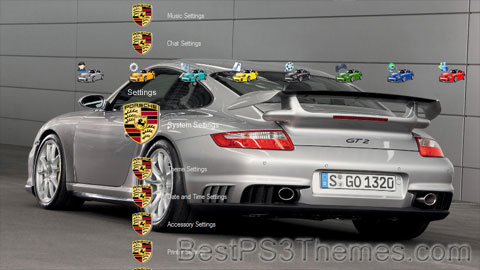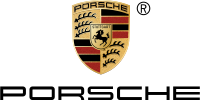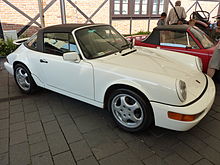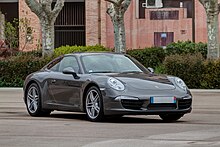Porsche theme by Jerec
Download: Porsche.p3t

(3 backgrounds)
 | |
 Headquarters in Stuttgart | |
| Company type | Public (AG) |
|---|---|
| FWB: P911 DAX component | |
| ISIN | DE000PAG9113 |
| Industry | Automotive |
| Founded | 1931 in Stuttgart, Germany |
| Founder | Ferdinand Porsche |
| Headquarters | Stuttgart, Germany |
Area served | Worldwide |
Key people | Wolfgang Porsche (chairman) Oliver Blume (CEO)[1] |
| Products | Automobiles |
Production output | |
| Services | Automotive financial services, engineering services, investment management |
| Revenue | |
| Total assets | |
| Total equity | |
| Owners |
|
Number of employees | 39,162 (2022)[2] |
| Subsidiaries |
|
| Website | www |
Dr. Ing. h.c. F. Porsche AG, usually shortened to Porsche (German pronunciation: [ˈpɔʁʃə] ; see below), is a German automobile manufacturer specializing in luxury, high-performance sports cars, SUVs and sedans, headquartered in Stuttgart, Baden-Württemberg, Germany. The company is owned by Volkswagen AG, a controlling stake of which is owned by Porsche Automobil Holding SE. Porsche's current lineup includes the 718, 911, Panamera, Macan, Cayenne and Taycan.
The origins of the company date to the 1930s when Czech-German automotive engineer Ferdinand Porsche founded Porsche[4] with Adolf Rosenberger, a keystone figure in the creation of German automotive manufacturer and Audi precursor Auto Union,[5] and Austrian businessman Anton Piëch, who was, at the time, also Ferdinand Porsche's son in law. In its early days, it was contracted by the German government to create a vehicle for the masses, which later became the Volkswagen Beetle.[6] After World War II, when Ferdinand would be arrested for war crimes, his son Ferry Porsche began building his own car, which would result in the Porsche 356.
In 2009, Porsche entered an agreement with Volkswagen to create an 'integrated working group' by merging the two companies' car manufacturing operations.[7][8] By 2015, Porsche SE, the holding company spun off from the original Porsche firm, had a controlling interest in the Volkswagen Group, which included Audi and Lamborghini as subsidiaries.[9]
History[edit]
Origin[edit]
Ferdinand Porsche (1875–1951) founded the company called "Dr. Ing. h. c. F. Porsche GmbH"[4] with Adolf Rosenberger[10] and Anton Piëch in 1931.[11] The name is short for Ferdinand Porsche's full title in German, Doktor Ingenieur honoris causa lit. 'Doctor of Engineering, Honorary Degree' Ferdinand Porsche.[12] The main offices was at Kronenstraße 24 in the centre of Stuttgart.[13] Initially, the company offered motor vehicle development work and consulting,[4] but did not build any cars under its own name. One of the first assignments the new company received was from the German government to design a car for the people; that is, a Volkswagen.[4] This resulted in the Volkswagen Beetle, one of the most successful car designs of all time.[6] Later, the Porsche 64 would be developed in 1939 using many components from the Beetle.[4]


During World War II,[14] Volkswagen production turned to the military version of the Volkswagen Beetle, the Kübelwagen,[14] 52,000 produced, and Schwimmwagen,[14] 15,584 produced.[15] Porsche produced several designs for heavy tanks during the war, losing out to Henschel & Son in both contracts that ultimately led to the Tiger I and the Tiger II. However, not all this work was wasted, as the chassis Porsche designed for the Tiger I was used as the base for the Elefant tank destroyer. Porsche also developed the Maus super-heavy tank in the closing stages of the war, producing two prototypes.[16] Ferdinand Porsche's biographer, Fabian Müller, wrote that Porsche had thousands of people forcibly brought to work at their factories during the war. The workers wore the letter "P" on their clothing at all times. It stood not for "Porsche", but for "Poland".[17]
At the end of World War II in 1945, the Volkswagen factory at KdF-Stadt fell to the British. Ferdinand lost his position as chairman of the board of management of Volkswagen, and Ivan Hirst, a British Army major, was put in charge of the factory. (In Wolfsburg, the Volkswagen company magazine dubbed him "The British Major who saved Volkswagen".)[18] On 15 December of that year, Ferdinand was arrested for war crimes, but not tried. During his 20-month imprisonment, Ferdinand Porsche's son, Ferry Porsche, decided to build his own car, because he could not find an existing one that he wanted to buy. He also had to steer the company through some of its most difficult days until his father's release in August 1947.[19]
The first models of what was to become the 356 were built in a small sawmill in Gmünd, Austria.[19] The prototype car was shown to German auto dealers, and when pre-orders reached a set threshold, production (with aluminum body) was begun by Porsche Konstruktionen GesmbH, founded by Ferry and Louise. Many regard the 356 as the first Porsche simply because it was the first model sold by the fledgling company. After production of the 356 was taken over by the father's Dr. Ing. h.c. F. Porsche GmbH in Stuttgart in 1950, Porsche commissioned a Zuffenhausen-based company, Reutter Karosserie, which had previously collaborated with the firm on Volkswagen Beetle prototypes, to produce the 356's steel body. In 1952, Porsche constructed an assembly plant (Werk 2) across the street from Reutter Karosserie; the main road in front of Werk 1, the oldest Porsche building, is now known as Porschestrasse.[20] The 356 was road-certified in 1948.
Company logo[edit]
Porsche's company logo stems from the coat of arms of the Free People's State of Württemberg of Weimar Germany of 1918–1933, which had Stuttgart as its capital. (The Bundesland of Württemberg-Hohenzollern used the same arms from 1945 to 1952, while Stuttgart during these years operated as the capital of adjacent Württemberg-Baden.) The arms of Stuttgart appear in the middle of the logo as an inescutcheon, for the company had its headquarters in Stuttgart. The heraldic symbols, combined with the texts "Porsche" and "Stuttgart", do not form a conventional coat of arms, since heraldic achievements never spell out the name of the armiger nor the armiger's home town in the shield.
Württemberg-Baden and Württemberg-Hohenzollern both in 1952 became part of the present Bundesland of Baden-Württemberg after the political consolidation of West Germany in 1949, but the old design of the arms of Württemberg lives on in the Porsche logo. On 30 January 1951, not long before the formation of Baden-Württemberg, Ferdinand Porsche died from complications following a stroke.
Developments[edit]

In post-war Germany, parts were generally in short supply, so the 356 automobile used components from the Volkswagen Beetle, including the engine case from its internal combustion engine, transmission, and several parts used in the suspension. The 356, however, had several evolutionary stages, A, B, and C, while in production, and most Volkswagen-sourced parts were replaced by Porsche-made parts. Beginning in 1954 the 356s engines started utilizing engine cases designed specifically for the 356. The sleek bodywork was designed by Erwin Komenda, who also had designed the body of the Beetle. Porsche's signature designs have, from the beginning, featured air-cooled rear-engine configurations (like the Beetle), rare for other car manufacturers, but producing automobiles that are very well balanced.
In 1964, after a fair amount of success in motor-racing with various models including the 550 Spyder, and with the 356 needing a major re-design, the company launched the Porsche 911: another air-cooled, rear-engined sports car, this time with a six-cylinder "boxer" engine. The team to lay out the body shell design was led by Ferry Porsche's eldest son, Ferdinand Alexander Porsche (F. A.). The design phase for the 911 caused internal problems with Erwin Komenda, who led the body design department until then. F. A. Porsche complained Komenda made unauthorized changes to the design. Company leader Ferry Porsche took his son's drawings to neighbouring chassis manufacturer Reuter. Reuter's workshop was later acquired by Porsche (so-called Werk 2). Afterward, Reuter became a seat manufacturer, today known as Keiper-Recaro.

The design office gave sequential numbers to every project (See Porsche type numbers), but the designated 901 nomenclature contravened Peugeot's trademarks on all 'x0x' names, so it was adjusted to 911. Racing models adhered to the "correct" numbering sequence: 904, 906, 908. The 911 has become Porsche's most well-known model – successful on the race-track, in rallies, and in terms of road car sales. It remains in production; however, after several generations of revision, current-model 911s share only the basic mechanical configuration of a rear-engined, six-cylinder coupé, and basic styling cues with the original car. A cost-reduced model with the same body, but with a 356-derived four-cylinder engine, was sold as the 912.
In 1972, the company's legal form was changed from Kommanditgesellschaft (KG), or limited partnership, to Aktiengesellschaft (AG), or public limited company, because Ferry Porsche came to believe the scale of the company outgrew a "family operation", after learning about Soichiro Honda's "no family members in the company" policy at Honda. This led to the establishment of an executive board with members from outside the Porsche family, and a supervisory board consisting largely of family members. With this change, most family members in the operation of the company, including F. A. Porsche and Ferdinand Piëch, departed from the company.
F. A. Porsche founded his own design company, Porsche Design, which is renowned for exclusive sunglasses, watches, furniture, and many other luxury articles. Louise's son and Ferry's nephew Ferdinand Piëch, who was responsible for mechanical development of Porsche's production and racing cars (including the very successful 911, 908 and 917 models), formed his own engineering bureau, and developed a five-cylinder-inline diesel engine for Mercedes-Benz. A short time later he moved to Audi (used to be a division, then a subsidiary, of Volkswagen), and pursued his career through the entire company, ultimately becoming the chairman of Volkswagen Group.
The first chief executive officer (CEO) of Porsche AG was Ernst Fuhrmann, who had been working in the company's engine development division. Fuhrmann was responsible for the so-called Fuhrmann-engine, used in the 356 Carrera models as well as the 550 Spyder, having four overhead camshafts instead of a central camshaft with pushrods, as in the Volkswagen-derived serial engines. He planned to cease the 911 during the 1970s and replace it with the V8-front engined grand sportswagon 928. As we know today, the 911 outlived the 928 by far. Fuhrmann was replaced in the early 1980s by Peter W. Schutz, an American manager and self-proclaimed 911 aficionado. He was then replaced in 1988 by the former manager of German computer company Nixdorf Computer AG, Arno Bohn, who made some costly miscalculations that led to his dismissal soon after, along with that of the development director, Dr. Ulrich Bez, who was formerly responsible for BMW's Z1 model, and was CEO of Aston Martin from 2000 to 2013.[21]

In 1990, Porsche drew up a memorandum of understanding with Toyota to learn and benefit from Japanese lean manufacturing methods. In 2004 it was reported that Toyota was assisting Porsche with hybrid technology.[22]
Following the dismissal of Bohn, Heinz Branitzki, a longtime Porsche employee, was appointed as interim CEO. Branitzki served in that position until Wendelin Wiedeking became CEO in 1993. Wiedeking took over the chairmanship of the board at a time when Porsche appeared vulnerable to a takeover by a larger company. During his long tenure, Wiedeking transformed Porsche into a very efficient and profitable company.
Ferdinand Porsche's nephew, Ferdinand Piëch, was chairman and CEO of the Volkswagen Group from 1993 to 2002 and is chairman of the Volkswagen AG Supervisory Board since then. With 12.8 percent of the Porsche SE voting shares, he also remains the second-largest individual shareholder of Porsche SE after his cousin, F. A. Porsche, which had 13.6 percent.
Porsche's 2002 introduction of the Cayenne also marked the unveiling of a new production facility in Leipzig, Saxony, which once accounted for nearly half of Porsche's annual output. In 2004, production of the 456 kilowatts (620 PS; 612 bhp) Carrera GT commenced in Leipzig, and at EUR 450,000 ($440,000 in the United States) it was the most expensive production model Porsche ever built.

In mid-2006, after years of the Boxster (and later the Cayenne) as the best selling Porsche in North America, the 911 regained its position as Porsche's best-seller in the region. The Cayenne and 911 have cycled as the top-selling model since. In Germany, the 911 outsells the Boxster/Cayman and Cayenne.[23]
In May 2011, Porsche Cars North America announced plans to spend $80–$100 million, but will receive about $15 million in economic incentives to move their North American headquarters from Sandy Springs, a suburb of Atlanta, to Aerotropolis, Atlanta, a new mixed-use development on the site of the old Ford Hapeville plant adjacent to Atlanta's airport.[24] Designed by architectural firm HOK, the headquarters will include a new office building and test track.[25][26][27] The facility will be known by its new address, One Porsche Drive.
In October 2017, Porsche Cars North America announced the launch of Porsche Passport,[28] a new sports car and SUV subscription program. This new offering allows consumers to access Porsche vehicles through subscribing to the service, rather than owning or leasing a vehicle. The Porsche Passport service was available initially in Atlanta,[29][30] and has become available in many major cities across the US.[31]
During the COVID-19 pandemic, in March 2020, Porsche suspended its manufacturing in Europe for two weeks, "By taking this step, the sports car manufacturer is responding to the significant acceleration in the rate of infection caused by the coronavirus and the resultant measures implemented by the relevant authorities."[32]
In August 2022, Bloomberg News reported that Porsche has lined up interest in subscription of its initial public offering for a valuation between US$60–85 billion. It is expected to be listed on Frankfurt Stock Exchange in September.[33]
Relationship with Volkswagen[edit]

The company has always had a close relationship with, initially, the Volkswagen (VW) marque, and later, the Volkswagen Group (which also owns Audi AG), because the first Volkswagen Beetle was designed by Ferdinand Porsche.
The two companies collaborated in 1969 to make the VW-Porsche 914 and 914-6, whereby the 914-6 had a Porsche engine, and the 914 had a Volkswagen engine. Further collaboration in 1976 resulted in the Porsche 912E (US only) and the Porsche 924, which used many Audi components, and was built at Audi's Neckarsulm factory, which had been NSU's. Porsche 944s were also built there,[34] although they used far fewer Volkswagen components. The Cayenne, introduced in 2002, shares its chassis with the Volkswagen Touareg and the Audi Q7, which is built at the Volkswagen Group factory in Bratislava, Slovakia.
Corporate restructuring[edit]




